On this Day in History ... 3rd May
03 May is in May.
Events on the 3rd May
Around 03 May 1060 Archbishop Cynesige consecrated Waltham Abbey [Map] in the presence of King Edward "Confessor" of England (age 57) at the invitation of Harold Godwinson (age 38).
On 03 May 1123 Felicia Montdidier Queen Consort Aragon and Pamplona (age 63) died.
On 01 May 1238 or 03 May 1238 King Magnus VI of Norway was born to King Haakon IV of Norway (age 34).
On 03 May 1421 John Clifford 7th Baron Clifford (age 32) was appointed 137th Knight of the Garter by King Henry V of England (age 34).

On 03 May 1421 Walter Hungerford 1st Baron Hungerford (age 42) was appointed 134th Knight of the Garter by King Henry V of England (age 34).

On 03 May 1421 Louis Robbessart (age 31) was appointed 135th Knight of the Garter by King Henry V of England (age 34).
Croyland Chronicle. Around 03 May 1483 . These reports having reached London on the following night, queen Elizabeth (age 46) betook herself, with all her children, to the sanctuary at Westminster. In the morning you might have seen there the adherents of both parties, some sincerely, others treacherously, on account of the uncertainty of events, siding with the one party or the other. For some collected their forces at Westminster in the queen's name, others at London under the shadow of the lord Hastings, and took up their position there.
Around 03 May 1483 Elizabeth Woodville Queen Consort England (age 46) took Sanctuary, Westminster Abbey [Map] with Richard of Shrewsbury 1st Duke of York (age 9) and Thomas Grey 1st Marquess Dorset (age 28). Her brother Bishop Lionel Woodville (age 36) was with her. 


Letters 1536. 03 May 1536. Otho, C. x. 226. B. M. Burnet, i. 320. 792. [Cranmer (age 46) to Henry VIII.]
Have come to Lambeth, according to Mr. Secretary's letters, to know your Grace's pleasure. Dare not, contrary to the said letters, presume to come to your presence, but of my bounden duty I beg you "somewhat to suppress the deep sorrows of your Grace's heart," and take adversity patiently. Cannot deny that you have great causes of heaviness, and that your honor is highly touched. God never sent you a like trial; but if He find you no less patient and thankful than when all things succeeded to your wish, I suppose you never did thing more acceptable to Him. You will give Him occasion to increase His benefits, as He did to Job. If the reports of the Queen (age 35) be true, they are only to her dishonor, not yours. I am clean amazed, for I had never better opinion of woman; but I think your Highness would not have gone so far if she had not been culpable. I was most bound to her of all creatures living, and therefore beg that I may, with your Grace's favor, wish and pray that she may declare herself innocent. Yet if she be found guilty, I repute him not a faithful subject who would not wish her punished without mercy. "And as I loved her not a little for the love which I judged her to bear towards God and His Gospel, so if she be proved culpable there is not one that loveth God and His Gospel that ever will favor her, but must hate her above all other; and the more they favor the Gospel the more they will hate her, for then there was never creature in our time that so much slandered the Gospel; and God hath sent her this punishment for that she feignedly hath professed his Gospel in her mouth and not in heart and deed." And though she have so offended, yet God has shown His goodness towards your Grace and never offended you. "But your Grace, I am sure, knowledgeth that you have offended Him." I trust, therefore, you will bear no less zeal to the Gospel than you did before, as your favor to the Gospel was not led by affection to her. Lambeth, 3 May.
Since writing, my lords Chancellor, Oxford, Sussex, and my Lord Chamberlain of your Grace's house, sent for me to come to the Star Chamber, and there declared to me such things as you wished to make me privy to. For this I am much bounden to your Grace. They will report our conference. I am sorry such faults can be proved against the Queen as they report.
Hol. Mutilated. Endd.
Letters 1536. 03 May 1536. Otho, C. x. 225. B. M. Ellis, i Ser. II. 53. Singer's Cavendish, ii. 217. 793. Sir William Kingston (age 60) to [Cromwell].
On my Lord of Norfolk (age 63) and the King's Council departing from the Tower, I went before the Queen (age 35) into her lodging. She said unto me, "Mr. Kingston (age 60), shall I go into a dungeon?" I said, "No, Madam. You shall go into the lodging you lay in at your coronation." "It is too g[ood] for me, she said; Jesu have mercy on me;" and kneeled down, weeping a [good] pace, and in the same sorrow fell into a great laughing, as she has done many times since. "She desyred me to move the Kynges hynes that she [might] have the sacarment in the closet by hyr chamber, that she my[ght pray] for mercy, for I am as clere from the company of man as for s[in as I] am clear from you, and am the Kynges trew wedded wyf. And then s[he said], Mr. Kynston, do you know wher for I am here? and I sayd, Nay. And th[en she asked me], When saw you the Kynge? and I sayd I saw hym not syns I saw [him in] the Tylte Yerde. And then, Mr. K., I pray you to telle me wher my [Lord, my fa]der [Thomas Boleyn 1st Earl Wiltshire and Ormonde (age 59)], ys? And I told hyr I saw hym afore dyner in the Cort. O[where is m]y sweet broder (age 33)? I sayd I left hym at York Place; and so I dyd. I [hear say, sai]d she, that I shuld be accused with iij. men; and I can say [no more but] nay, withyowt I shuld oppen my body. And ther with opynd her gown. O, No[res] (age 54), hast thow accused me? Thow ar in the Towre with me, [and thow and I shall] dy together; and, Marke (age 24), thow art here to. O, my mother (age 56), [thou wilt die with] sorow; and myche lamented my lady of Worceter (age 34), for by c[ause that her child di]d not store in hyre body. And my wyf sayd, what shuld [be the cause? And she sai]d, for the sorow she toke for me. And then she sayd, Mr. [Kyngston (age 60), shall I die with]yowt justes? And I sayd, the porest sugett the Ky[ng hath, hath justice. And t]her with she lawed. Alle thys sayinges was yesterny[ght] .... and thys mornyng dyd talke with Mestrys Co[fyn. And she said, Mr. Norr]es Henry Norreys (age 54) dyd say on Sunday last unto the Quenes am[ner that he would s]vere for the Quene that she was a gud woman. [And then said Mrs.] Cofyn (age 36), Madam, Why shuld ther be hony seche maters [spoken of? Marry,] sayd she, I bad hym do so: for I asked hym why he [did not go through with] hys maryage, and he made ansure he wold tary [a time. Then I said, Y]ou loke for ded men's showys, for yf owth ca[m to the King but good], you would loke to have me. And he sayd yf he [should have any such thought] he wold hys hed war of. And then she sayd [she could undo him if she wou]ld; and ther with thay felle yowt, bot .... and sayd on Wysson Twysday last .... that Nores (age 54) cam more .. age and further ....



"Wher I was commaunded to charge the gentelwomen that gyfes thayr atendans apon the Quene, that ys to say thay shuld have now (i.e., no) commynycasion with hyr in lese my wyf (age 60) ware present; and so I dyd hit, notwithstandynge it canot be so, for my Lady Bolen and Mestrys Cofyn (age 36) lyes on the Quenes palet, and I and my wyf at the dore with yowt, so at thay must nedes talke at be within; bot I have every thynge told me by Mestrys Cofyn (age 36) that she thinkes met for you to know, and tother ij. gentelweymen lyes withyowt me, and as I may knowe t[he] Kynges plesure in the premysses I shalle folow. From the Towre, thys morny[ng].

"Sir, syns the makynge of thys letter the Quene spake of Wes[ton [Francis Weston (age 25)], saying that she] had spoke to hym bycause he did love hyr kynswoman [Mrs. Skelton, and] sayd he loved not hys wyf (age 22), and he made ansere to hyr [again that h]e loved wone in hyr howse better then them bothe. And [the Queen (age 35) said, Who is] that? It ys yourself. And then she defyed hym, as [she said to me]. William Kyngston (age 60)."

Hol.
Henry Machyn's Diary. 03 May 1551. The iij day of May ther was a grett tryhumpe at Grenwyche [Map]. The Kyng (age 13) and alle ys compeny wher alle blacke and whyt, fott men and trumpeters, hats, clokes, and baners blacke and whytt, and speres; and the thodur parte was the yerle of Harfford (age 51), and a grett compeny of lords and knyghts, alle yonge men, and trompeters, ther hats, baners, and fott men alle in yelow, and so they rayne [at the] rynge, and at tornay with swords-the v yer K. E. vjth.
A great triumph at Greenwich. Thus noticed in the King's diary:
"March 31. A chaleng made by me that I, with 16 of my chaumbre, shuld runne at base, shote, and rune at ring, with any 17 of my servauntes, gentlemen in the court." —
"May 3. The chaleng at running at ringe performed, at the wich first came the kinge, 16 footmen, and 10 hor[se]men, in blake silk cootes pulled out with wight tafeta; then al lordes, having three [sic. qu. their] men likewise appareled, and al gentlemen, ther footmen in whit fustian pulled out with blake taveta. The tother side came al in yelow tafta. At lenght the yelow band toke it thrise in 120 courses, and my band tainted often, wich was counted as nothing, and toke never, wich seemed very straunge, and so the price was of my side lost. After that turnay folowed, betwen 6 of my band and sixe ofthers."
Henry Machyn's Diary. 03 May 1554. The iij day of May, at the cowrt of sant James, the quen('s) (age 38) grace whent a prossessyon within sant James with harolds and serjants of armes, and iiij bysshopes mytred, and all iij days thay whent her chapell a-bowt the feldes, first day to sant Gylles and ther song masse; the next day tuwyse-day to sant Martens in the feldes [Map], [and there] a sermon and song masse, and so thay dronke ther; and the iij day to Westmynster, and ther a sermon and then masse, and mad good chere; and after a-bowt the Parke, and so to sant James cowrt ther.
On 03 May 1584 William Ruthven 1st Earl Gowrie (age 41) was beheaded at Stirling Castle [Map] for continuing to rebel against the King. His son James Ruthven 2nd Earl Gowrie (age 8) succeeded 2nd Earl Gowrie
On 03 May 1642 William Waller (age 45) was elected MP Andover during the Long Parliament.
Pepy's Diary. 03 May 1661. Early to walk with Mr. Creed up and down the town, and it was in his and some others' thoughts to have got me made free of the town, but the Mayor, it seems, unwilling, and so they could not do it. Then to the payhouse, and there paid off the ship, and so to a short dinner, and then took coach, leaving Mrs. Hater there to stay with her husband's friends, and we to Petersfield, Hampshire, having nothing more of trouble in all my journey, but the exceeding unmannerly and most epicure-like palate of Mr. Creed. Here my wife and I lay in the room the Queen (age 51) lately lay at her going into France.
On 03 May 1682 the Duke of York (age 48) and his retinue including John Churchill 1st Duke of Marlborough (age 31) and George Legge 1st Baron Dartmouth (age 35) were seen off on their journey north by King Charles I of England, Scotland and Ireland from Margate Roads, Kent [Map]. James (age 48) was possibly travelling to Edinburgh to collect his six months pregnant wife Mary of Modena (age 23) to ensure their child was born in England.


Evelyn's Diary. 03 May 1699. At a meeting of the Royal Society I was nominated to be of the committee to wait on the Lord Chancellor (age 44) to move the King (age 48) to purchase the Bishop of Worcester's library (Dr. Edward Stillingfleet).
On 03 May 1702 John St John 2nd Viscount St John was born to Henry St John 1st Viscount St John (age 49) and Angelica Magdalena Pellissary Viscountess St John (age 36).
On 03 May 1772 John Parker 1st Earl Morley was born to John Parker 1st Baron Boringdon (age 37) and Theresa Robinson Baroness Boringdon.

On 03 May 1795 Richard James Wyatt was born to Edward Wyatt (age 38) and Anne Maddox in Oxford Street, London. He was baptised on 06 Jun 1795.
On 03 May 1804 Harriet Baring Marchioness Bath was born to Alexander Baring 1st Baron Ashburton (age 29) and Ann Louisa Bingham Baroness Ashburton (age 22).
Benty Grange. May 3rd. - It was our good fortune to open a barrow which afforded a more instructive collection of relics than has ever been discovered in the county, and which are not surpassed in interest by any remains hitherto recovered from any Anglo-Saxon burying place in the kingdom.
The barrow [Benty Grange Barrow [Map]], which is on a farm called Benty Grange, a high and bleak situation to the right of the road from Ashbourn to Buxton, near the eighth milestone from the latter place, is of inconsiderable elevation, perhaps not more than two feet at the highest point, but is spread over a pretty large area, and is surrounded by a small fosse or trench. About the centre and upon the natural soil, had been laid the only body the barrow ever contained, of which not a vestige besides the hair could be distinguished. Near the place which, from the presence of hair, was judged to have been the situation of the head, was a curious assemblage of ornaments, which, from the peculiarly indurated nature of the earth, it was impossible to remove with any degree of success. The most remarkable are the silver edging and ornaments of a leathern cup, about three inches diameter at the mouth, which was decorated by four wheel-shaped ornaments and two crosses of thin silver, affixed by pins of the same metal, clenched inside.
The other articles found in the same situation consist of personal ornaments, the chief of which are two circular enamels upon copper 1¾ diameter, in narrow silver frames, and a third, which was so far decomposed as to be irrecoverable; they are enamelled with a yellow interlaced dracontine pattern, intermingled with that peculiar scroll design, visible on the same class of ornaments figured in Vestiges p. 25, and used in several manuscripts of the Vllth Century, for the purpose of decorating the initial letters. The principle of this design consists of three spiral lines springing from a common centre, and each involution forming an additional centre for an extension of the pattern, which may be adapted to fill spaces of almost any form. Mr. Westwood has shown in a most able paper in the 40th No. of the Journal of the Archæological Institute, that this style of ornamentation is peculiar to the Anglo-Saxon and Irish Artists of the period before stated. The pattern was first cut in the metal, threads of it being left to show the design, by which means cells were formed, in which the enamel was placed before fusion, the whole being then polished became what is known as Champ-levé enamel. There was also with these enamels a knot of very fine wire, and a quantity of thin bone variously ornamented with lozenges &c, which was mostly too much decayed to bear removal; it appeared to have been attached to some garment of silk, as the glossy fibre of such a fabric was very perceptible when they were first uncovered, though it shortly vanished when exposed to the air. Proceeding westward from the head for about six feet, we arrived at a large mass of oxidyzed iron, which, being removed with the utmost care, and having been since repaired, were unavoidably broken, now presents a mass of chainwork, and the frame of a helmet. The latter consists of a skeleton formed of iron bands, radiating from the crown of the head, and riveted to a circle of the same metal which encompassed the brow: from the impression on the metal it is evident that the outside was covered with plates of horn disposed diagonally so as to produce a herring-bone pattern, the ends of these plates were secured beneath with strips of horn corresponding with the iron framework, and attached to it by ornamental rivets of silver at intervals of about an inch and a half from each other; on the bottom of the front rib, which projects so as to form a nasal, is a small silver cross slightly ornamented round the edges by a beaded moulding; and on the crown of the helmet is an elliptical bronze plate supporting the figure of an animal carved in iron, with bronze eyes, now much corroded, but perfectly distinct as there presentation of a hog. There are too, many fragments, some more or less ornamented with silver, which have been riveted to some part of the helmet in a manner not to be explained or even understood, there are also some small buckles of iron which probably served to fasten it upon the head. Amongst the chainwork is a very curious six-pronged instrument of iron, in shape much like an ordinary hay-fork, with the difference of the tang, which in the latter is driven into the shaft, being in this instrument flattened and doubled over so as to form a small loop apparently convenient for suspension; whether it belonged to the helmet or the corselet, next to be described, is uncertain. The iron chainwork already named, consists of a large number of links of two kinds, attached to each other by small rings half an inch diameter; one kind are flat and lozenge, shaped, about an inch and a half long; the others are all of one kind but of different lengths, varying from 4 to 10 inches. They are simply lengths of square rod iron with perforated ends, through which pass the rings connecting them with the diamond shaped links; they all show the impression of cloth over a considerable part of the surface, and it is therefore no improbable conjecture that they would originally constitute a kind of quilted cuirass, by being sewn up within, or upon a doublet of strong clotL The peculiarly indurated and corrosive nature of the soil in this barrow is a point of some interest, and it will not be out of place to state that such has generally been the case in tumuli in Derbyshire, where the more important Saxon burials have taken place, whilst the more ancient Celtic interments are generally found in good condition owing to there having been no special preparation of the earth, which in these cases has undergone a mixing or tempering with some corrosive liquid; the result of which is the presence of thin ochrey veins in the earth, and the decomposition of nearly the whole of the human remains. The following extract from Professor Worsaae's Antiquities of Denmark, illustrates the helmet which is the only example of the kind hitherto discovered either in this country or on the Continent.
"The helmets (of the ancient Scandinavians) which were furnished with crests, usually in the form of animals, were probably in most cases only the skins of the heads of animals, drawn over a framework of wood or leather, as the coat of mail was usually of strong quilted linen or thick woven cloth."
To this the translator of the English edition appends the important information, that "the animal generally represented was the boar; and it is to this custom that reference is made in Beowulf where the poet speaks of the boar of gold, the boar hard as iron."
"Swyn eal - gylden, Eofer Iren - heard."
Nor are allusions to this custom of wearing the figure of a boar - not in honour of the animal, but of Freya, to whom it was sacred - confined to Beowulf, they are to be found in the Edda and in the Sagas; while Tacitus in his work, De Moribus Germanorum, distinctly refers to the same usage and its religious intention, as propitiating the protection of their Goddess in battle. As a further illustration, not only of the helmet, but also of the chainwork, the following extracts from Beowulf are transcribed from Mr. 0. R. Smith's Collectanea Antiqua, vol. II, p. 240.
eofer-líc sciónon ofer-hleor beran; ge-hroden golde fah and fyr-heard, ferh-wearde heóld. Be-fongen freá-wrásnum, swa híne fyrn-dagum worhte waspna smith, wundrum teóde, be-sette swín-lícum, that hine sythan nó brond né beado-mecas bitan ne meahton: Æt thæm áde wæs eth-ge-syne swát-fah-syrce swyn eal-gylden, eofer íren heard; Hé thá in-beran eafor heáfod-segn, heago-steápne helm, [se] are-byman, guth-sweord geáto-líc:
They seemed a boar's form to bear over their cheeks; twisted with gold, variegated and hardened in the fire, this kept the guard of life: Surrounded with lordly chains, even as in days of yore the weapon smith had wrought it, had wondrously furnished it, [swine,] had set it round with the shapes of that never afterwards brand or war-knife might have power to bite it; At the pile was easy to be seen the mail shirt covered with gore, the hog of gold, the boar hard as iron: Then commanded he to bring in the boar, an ornament to the head, the helmet lofty in wars, the grey mail coat, the ready battle sword.
Note. The original and a reconstructed helmet are on display at the Weston Park Museum, Sheffield.
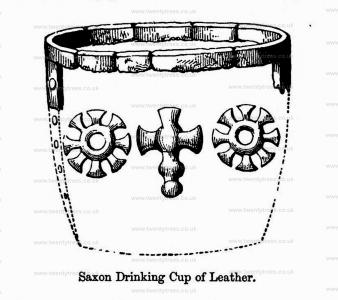
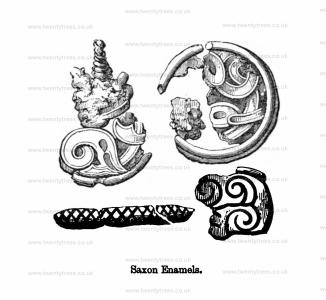
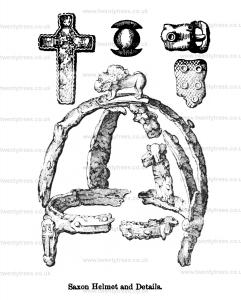
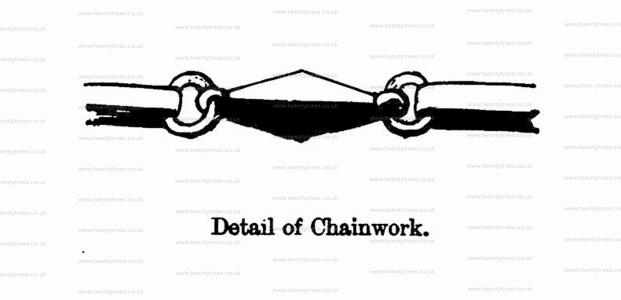
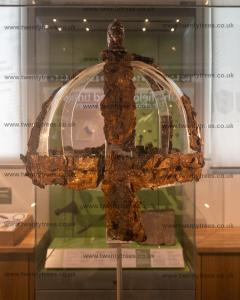
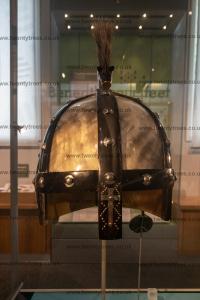
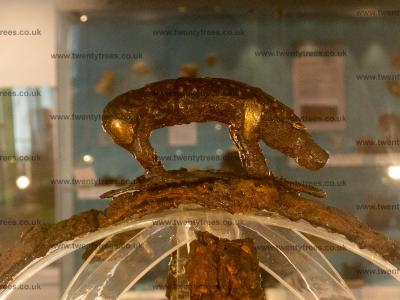
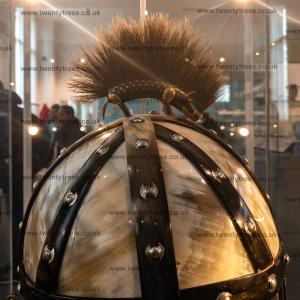
Youlgrave. On the 3rd of May, we made a second investigation of the tumulus at Bee Low [Map], near Youlgrave, which was first imperfectly opened by us in 1843, the excavation being then confined to the centre; but the mound being a bowl-shaped one, upwards of twenty yards diameter, it was thought worth while to make a further trial in it, which was begun by digging from the old cutting in the middle to the south side. The first discovery made when we had proceeded about three yards, was a skeleton lying on its left side with the knees drawn up, and the head to the east, so that the face was turned to the outside of the barrow. It was about eighteen inches below the surface of the mound, and did not seem to have been placed in a cist, although two or three courses of flat stones were carefully laid over it: near the head were three small instruments of bronze, two of them awls, and a few bits of the same metal that had been melted, and which had originally been small instruments of similar character. This skeleton having been taken up, we perceived the ground on the right or western side of the trench to decline; following this indication, we came to an irregular grave cut in the rock, the bottom about 4 feet 6 inches from the surface of the barrow: it was surrounded by a lining of small flat stones placed on edge, and within this lining was a regular pitching, like a street pavement, of clear chert stones very closely packed, extending over the whole grave; above them earth and stones had been thrown in without' order, but underneath them was the skeleton of a young person resting in the usual contracted position, with the head to the south-west, the elbows almost in contact with the thigh bones, and the hands in front of the face. At the angle formed by the bending of the knees, was a beautiful drinking-cup, only 6½ inches high, ornamented by two variations of the lozengy pattern; it still retained its upright position, and close to it was a very fine instrument of white flint, upwards of four inches long, which may have been used either as a knife or saw. While tracing out the western extremity of this grave, our attention was drawn to a very large stone, set up in a direction from S.E. to N.W., on a little higher level than the bottom of the grave, which was at length found to be one end of a rectangular cist, the other sides and cover of which were formed of similar slabs. Its internal dimensions were 3 feet 6 inches long, 2 feet wide, and 3 feet deep; and it was filled with stiff earth and small gravelly stone, amongst which, near the top, were fragments of calcined bone, and a small bronze awl or pin; removing the earth down to the floor (which was rock), we there found the bones composing the skeleton of an aged man, with a short round cranium, carefully placed in a heap in the middle, the long bones laid parallel with each other, and the skull put at the top of the heap, with the base upward. The bones being perfect, it is evident that this arrangement had been made whilst they were fresh and strong; and it is not a little singular that a similar mode of interment exists among the Patagonians, who make skeletons of their dead previous to burial. After removing these bones we found two small flints, and a piece of stag's horn at the bottom. Great quantities of rats' bones were found through the whole of the excavation, but they were observed to be most abundant and best preserved around the second interment, with which, it may be proper to mention, there was a single piece of an infant's skull, no other of its bones being found by a most careful examination. The accompanying plan represents the position of the various interments in the barrow; the flat stone shewn with burnt bones in the centre, being found in 1843.

On 03 May 1891 Ralph Beckett 3rd Baron Grimthorpe was born to Ernest William Beckett 2nd Baron Grimthorpe (age 34) and Lucy Tracy Lee.
The London Gazette 26509. Whitehall, May 3, 1894
The Queen (age 74) has been pleased to direct Letters Patent to be passed under the Great Seal of the United Kingdom of Great Britain and Ireland, granting the dignity of a Baronet of the said United Kingdom unto Edward Coley Burne Burne-Jones (age 60), of Rottingdean, in the county of Sussex, and of the Grange, in the parish of Fulham, in the county of London, Esquire, and the heirs male of his body lawfully begotten. [Note. Georgiana Macdonald Lady Burne-Jones (age 53) by marriage Lady Burne-Jones of Rottingdean in Sussex and The Grange in Fulham in London]
After 03 May 1911. Memorial to 2nd Lieutenant Agnew Appleton of the 2/4 West Riding Regiment kille in action at Bullecourt.
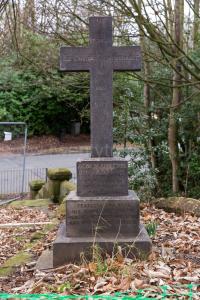
After 03 May 2004. Cavendish Plot, St Peter's Church, Edensor [Map]. Andrew Cavendish 11th Duke Devonshire (deceased) and Deborah Vivien Mitford Duchess Devonshire (age 84).
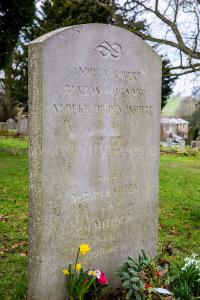
Births on the 3rd May
On 01 May 1238 or 03 May 1238 King Magnus VI of Norway was born to King Haakon IV of Norway (age 34).
On 03 May 1276 Louis I Count Évreux was born to Philip "Bold" III King France (age 31) and Maria Reginar Queen Consort France (age 20). He a great x 3 grandson of King Henry "Curtmantle" II of England.
Around 03 May 1318 John Lisle 2nd Baron Lisle was born to Robert Lisle 1st Baron Lisle (age 30) and Margaret Beauchamp Baroness Lisle (age 23).

On 03 May 1355 Bryan Cornwall 4th Baron Burford was born to Geoffrey Cornwall 3rd Baron Burford (age 19) at Stokesay, Shropshire.
On 03 May 1415 Cecily "Rose of Raby" Neville Duchess York was born to Ralph Neville 1st Earl of Westmoreland (age 51) and Joan Beaufort Countess of Westmoreland (age 36) at Raby Castle, County Durham [Map]. She a great granddaughter of King Edward III of England.

On 03 May 1446 Margaret of York Duchess of Burgundy was born to Richard Plantagenet 3rd Duke of York (age 34) and Cecily "Rose of Raby" Neville Duchess York (age 31) at Fotheringay Castle, Northamptonshire [Map]. She a great x 2 granddaughter of King Edward III of England. Coefficient of inbreeding 2.42%. 

On 03 May 1479 Henry V Duke of Mecklenburg was born to Magnus II Duke of Mecklenburg (age 38).
On 03 May 1509 John Trastámara was born to Ferdinand II King Aragon (age 57) and Germaine Foix Queen Consort Aragon (age 21). Coefficient of inbreeding 3.82%. 
On 03 May 1511 Anne Cresacre was born to Edward Cresacre (age 26).
On 03 May 1513 Christopher Neville was born to Richard Neville 2nd Baron Latimer of Snape (age 45) and Anne Stafford Baroness Latimer (age 42).

On 03 May 1528 Humphrey Archer of Umberslade was born to Richard Archer (age 23) and Maud aka Matilda Delamere.
On 03 May 1553 Thomas Bedingfield was born to Thomas Bedingfield (age 33).
Around 03 May 1595 Helen Gascoigne was born to John Gascoigne 1st Baronet (age 38).
On 03 May 1600 Dorothy Darcy was born to Conyers Darcy 7th Baron Darcy of Knayth, 1st Baron Darcy Meinhill, 4th Baron Conyers (age 29) and Dorothy Belasyse Baroness Darcy and Conyers (age 28).

On 03 May 1602 Thomas Hungerford was born to John Hungerford (age 44) at Bremhill, Wiltshire.
On 03 May 1606 Marie Bourbon Condé Countess Soissons was born to Charles Bourbon Condé Count Soissons (age 39) and Anne Montafié Countess Soissons (age 28).
On 03 May 1617 Roger Pepys was born to Talbot Pepys (age 34).
Before 03 May 1635 Cope Rich was born to Henry Rich 1st Earl Holland (age 44) and Isabel Cope Countess Holland.
On 03 May 1648 Humphrey Prideaux was born to Edmund Prideaux (age 42) and Bridget Moyle (age 28).
On 03 May 1658 Henry Williams Cromwell was born to Henry Cromwell (age 30). And Elizabeth Russell.

On 03 May 1678 George Frederick Hohenzollern was born to John Frederick Hohenzollern (age 23).
On 22 Apr 1687 or 03 May 1687 Peter Bathurst was born to Benjamin Bathurst (age 48) and Frances Apsley (age 32).
On 03 May 1702 John St John 2nd Viscount St John was born to Henry St John 1st Viscount St John (age 49) and Angelica Magdalena Pellissary Viscountess St John (age 36).
On 03 May 1736 Robert Walpole was born to Horatio Walpole 1st Baron Walpole (age 57).
On 03 May 1740 George Bowyer 5th and 1st Baronet was born to William Bowyer 3rd Baronet (age 30) and Anne Stonhouse at Denham, Buckinghamshire.
On 03 May 1749 Prince George Frederick Hohenzollern was born to Friedrich Wilhelm Hohenzollern (age 48) and Sophia Dorothea Hohenzollern (age 30). He a great grandson of King George I of Great Britain and Ireland. Coefficient of inbreeding 2.05%.
On 03 May 1761 Archbishop Charles Brodrick was born to George Brodrick 3rd Viscount Midleton (age 30) and Albinia Townshend Viscountess Midleton.
On 03 May 1764 Henry Roper 12th Baron Teynham was born to Henry Roper 11th Baron Teynham (age 30).
On 03 May 1767 Anne Whitcombe was born to Robert Whitcombe.
On 03 May 1768 Charles Tennant was born.
On 03 May 1771 Arthur Chichester was born to Arthur Chichester 1st Marquess Donegal (age 31) and Anne Hamilton Countess Donegal (age 33).

On 03 May 1772 John Parker 1st Earl Morley was born to John Parker 1st Baron Boringdon (age 37) and Theresa Robinson Baroness Boringdon.

On 03 May 1773 Robert Balfour 6th of Balbirnie was born to John Balfour 5th of Balbirnie (age 35).
On 03 May 1773 Thomas Lyon Bowes 11th Earl Strathmore and Kinghorne was born to John Lyon 9th Earl Strathmore and Kinghorne (age 35) and Mary Bowes Countess Strathmore (age 24).
On 03 May 1776 John Savile Foljambe was born to Francis Ferrand Foljambe (age 27).
On 03 May 1785 George John Forbes was born to George Forbes 6th Earl Granard (age 25) and Selina Frances Rawdon Countess Granard (age 26).
On 03 May 1795 Richard James Wyatt was born to Edward Wyatt (age 38) and Anne Maddox in Oxford Street, London. He was baptised on 06 Jun 1795.
On 03 May 1804 Harriet Baring Marchioness Bath was born to Alexander Baring 1st Baron Ashburton (age 29) and Ann Louisa Bingham Baroness Ashburton (age 22).
On 03 May 1807 Thomas Aston Clifford-Constable 2nd Baronet was born to Thomas Hugh Clifford aka Constable 1st Baronet (age 44).
On 03 May 1809 Robert Devereux 15th Viscount Hereford was born to Henry Devereux 14th Viscount Hereford (age 32) and Frances Elizabeth Cornewall Viscountess Hereford (age 26).
On 03 May 1811 Arthur Henry Dyke was born to Thomas Dyke Acland 10th Baronet (age 24) and Elizabeth Hoare (age 24).

On 03 May 1814 Emily Louise Shepherd Countess Belmore was born to William Sheperd of Bradbourne in Kent and Anne Lovel Dawson.
On 03 May 1817 George Wentworth-Fitzwilliam was born to Charles Wentworth-Fitzwilliam 5th and 3rd Earl Fitzwilliam (age 30) and Mary Dundas (age 29). Coefficient of inbreeding 6.25%. 

On 03 May 1819 Edward Frederick Leveson-Gower was born to Granville Leveson-Gower 1st Earl Granville (age 45) and Harriet Cavendish Countess Granville (age 33).
On 03 May 1823 James McGarel-Hogg 1st Baron Magheramorne was born to James Hogg 1st Baronet (age 33) and Mary Swinton.
On 03 May 1823 William Harry Hay 19th Earl Erroll was born to William Hay 18th Earl Erroll (age 22) and Elizabeth Fitzclarence Countess Erroll (age 22). He a grandson of King William IV of the United Kingdom.
On 03 May 1826 Charles XV King Sweden IV King Norway was born to Oscar I King Sweden and Norway (age 26).
On 03 May 1826 Georgiana Maria Greville was born to Algernon Frederick Greville (age 27) and Charlotte Maria Cox.
On 03 May 1836 Henry Ryder 4th Earl of Harrowby was born to Dudley Ryder 2nd Earl of Harrowby (age 37) and Frances Stuart Countess Harrowby Lincolnshire.
On 03 May 1839 Countess Walburga Ehrengarde Helena von Hohenthal was born.
On 03 May 1848 Lewis Gordon was born to Charles Gordon 10th Marquess Huntly (age 56) and Maria Antoinetta Pegus Marchioness Huntly (age 27).
On 03 May 1851 George Banks Jenkinson 12th Baronet was born to George Samuel Jenkinson 11th Baronet (age 33) and Emily Sophia Lyster Lady Jenkinson.
On 03 May 1870 Helena Victoria Oldenburg was born to Prince Frederick Christian Oldenburg (age 39) and Helena Windsor (age 23). She a granddaughter of Queen Victoria of the United Kingdom.
On 03 May 1873 Mariota Thellusson Countess Wilton was born to Frederick William Brook Thellusson 5th Baron Rendlesham (age 33).
On 03 May 1875 Dudley Francis North was born to Dudley Francis North 7th Earl Guildford (age 23).
On 03 May 1878 Margaret Eleanor Furneaux Countess of Birkenhead was born to Henry Furneaux (age 48) and Eleanor Elizabeth Severn.
On 03 May 1891 Ralph Beckett 3rd Baron Grimthorpe was born to Ernest William Beckett 2nd Baron Grimthorpe (age 34) and Lucy Tracy Lee.
On 03 May 1905 Ronald Jervis 7th Viscount St Vincent was born to Ronald Jervis 6th Viscount St Vincent (age 45).
On 03 May 1922 Midshipman James Weyland Darling was born to Major John Clive Darling (age 34) and Eleanor Joan Martin Powell.
On 03 May 1932 John Monson 11th Baron Monson was born to John Roseberry Monson 10th Baron Monson (age 25).
On 03 May 1940 Henry Durand Hotham 8th Baron Hotham was born to Henry Hotham 7th Baron Hotham (age 40) and Letitia Sibell Winifred Brownlow-Cecil Baroness Hotham (age 36).

Marriages on the 3rd May
On 03 May 1275 Robert Bruce 5th Lord Annandale (age 60) and Christina Ireby Lady Annandale were married. She by marriage Lord Annandale. He a great x 4 grandson of King Henry I "Beauclerc" England.
After 03 May 1302 Edward Burnell (age 16) and Aline Despencer Baroness Burnell were married. She the daughter of Hugh "Elder" Despencer 1st Earl Winchester (age 41) and Isabella Beauchamp Baroness Monthermer (age 39). They were fourth cousins. He a great x 4 grandson of King John "Lackland" of England. She a great x 5 granddaughter of King Henry I "Beauclerc" England. 


Before 03 May 1317 Roger Damory 1st Baron Damory and Elizabeth Clare Lady Verdun (age 21) were married. She the daughter of Gilbert "Red Earl" Clare 7th Earl Gloucester 6th Earl Hertford and Joan of Acre Countess Gloucester and Hertford. She a granddaughter of King Edward "Longshanks" I of England. 

Before 03 May 1406 Roger Beauchamp 2nd Baron Beauchamp Bletsoe (age 43) and Margaret Holland Baroness Beauchamp Bletsoe were married. She by marriage Baroness Beauchamp Bletsoe in Bedfordshire.

On 03 May 1439 John Delves (age 17) and Ellen Egerton (age 19) were married at Doddington.

Before 03 May 1501 John Devereux 9th Baron Ferrers of Chartley (age 37) and Elizabeth Langham Baroness Ferrers Chartley (age 37) were married. She by marriage Baroness Ferrers of Chartley.
Before 03 May 1528 Richard Archer (age 23) and Maud aka Matilda Delamere were married.
On 03 May 1547 Henry Vernon (age 26) and Margaret Swynnerton (age 17) were married.
On or after 03 May 1632 Roger Lort 1st Baronet (age 24) and Hester Annesley (age 19) were married by a license dated 03 May 1632.
On 03 May 1637 John Bampfylde 1st Baronet (age 27) and Gertrude Coplestone were married.
Before 03 May 1663 John Dawes 1st Baronet (age 19) and Christian Hawkins were married without the permission of her guardian Andrew Riccard (age 59). Some sources refer to her as Christian Lyons, some Lygons.
On 03 May 1664 Robert Haselrigge 5th Baronet (age 24) and Bridget Rolle were married. They had four sons, three of whom died unmarried before the death of their father, and four daughters, three of whom died unmarried before the death of their father.
On 03 May 1681 Bourchier Wrey 4th Baronet (age 28) and Florence Rolle Lady Wrey (age 29) were married at St Giles' Church, St Giles in the Wood. She by marriage Lady Wrey of Trebitch in Cornwall. He the son of Chichester Wrey 3rd Baronet and Anne Bourchier Countess Middlesex (age 50).

On 03 May 1728 Henry Ingram 7th Viscount Irvine (age 37) and Ann Scarborough Viscountess Irvine (age 36) were married at Finchley.
On 03 May 1744 Richard Fitzwilliam 6th Viscount Fitzwilliam (age 32) and Catherine Decker were married.

On 03 May 1798 William James Comte d'Arran (age 20) and Caroline Gordon (age 26) were married. He a great x 2 grandson of King Charles II of England Scotland and Ireland. 
After 03 May 1798 William James Comte d'Arran (age 20) and Henrietta Susanah Montagu (age 20) were married. She the daughter of John Montagu 5th Earl Sandwich (age 54) and Maria Henrietta Powlett. He a great x 2 grandson of King Charles II of England Scotland and Ireland. 

On 03 May 1834 Spencer Bulkeley Wynn 3rd Baron Newborough (age 30) and Frances Maria De Winton Baroness Newborough were married at Great Malvern Priory [Map]. She by marriage Baroness Newborough of Newborough in County Wexford. They were half first cousins.
On 03 May 1836 Hugh Kerr aka McDonnell 4th Earl of Antrim (age 23) and Laura Parker Countess of Antrim (age 27) were married. She the daughter of Thomas Parker 5th Earl Macclesfield (age 73) and Eliza Wolstenholme Countess Macclesfield (age 55).
Before 03 May 1848 William Henry Pennyman (age 84) and Charlotte Robinson (age 82) were married.
On 03 May 1855 Rowland Hill aka Clegg-Hill 3rd Viscount Hill (age 21) and Mary Madax Viscountess Hill (age 25) were married. She the maid of his mother.
On 03 May 1887 Joseph Plunkett and Grace Gifford were married in the chapel of Kilmainham Gaol, Dublin, a few hours before he was executed.
On 03 May 1937 Ernest Aldrich Simpson (age 39) and Wallis Warfield aka Simpson Duchess of Windsor (age 40) were divorced.
Before 03 May 1940 Henry Hotham 7th Baron Hotham (age 40) and Letitia Sibell Winifred Brownlow-Cecil Baroness Hotham (age 36) were married. She the daughter of William Cecil 5th Marquess Exeter (age 63) and Myra Rowena Sibell Orde-Powlett Marchioness of Exeter (age 60).

Before 03 May 2005 Major Charles William Lambton (age 83) and Elizabeth Mary Petty-Fitzmaurice (age 78) were married. She the daughter of Henry Petty-Fitzmaurice 6th Marquess of Lansdowne. They were second cousins.
Deaths on the 3rd May
On 03 May 1123 Felicia Montdidier Queen Consort Aragon and Pamplona (age 63) died.
On 03 May 1152 Matilda Flanders (age 47) died. Her son Eustace Blois IV Count Boulogne (age 22) succeeded IV Count Boulogne.
On 03 May 1257 Katherine Plantagenet (age 3) died at Swallowfield, Berkshire. She was buried in the Ambulatory, Chancel, Westminster Abbey.
On 03 May 1270 Béla IV King of Hungary (age 64) died.
On 03 May 1274 John Courtenay 2nd Baron Okehampton (age 49) died. His son Hugh Courtenay 3rd Baron Okehampton (age 23) succeeded 3rd Baron Okehampton.
On 03 May 1286 Ranulph Dacre (age 40) died at Prescot, Lancashire.
On 03 May 1305 Robert Vaux (age 51) died.
On 03 May 1366 Thomas Astley 3rd Baron Astley (age 58) died. His son William Astley 4th Baron Astley (age 26) succeeded 4th Baron Astley. Joan Willoughby Baroness Astley (age 21) by marriage Baroness Astley.
On 03 May 1376 Archbishop Wiliam Melun died.
On 03 May 1407 Bishop Richard Mitford died. He was buried in the Salisbury Cathedral [Map].
On 03 May 1409 Robert Wingfield (age 31) died at Letheringham, Suffolk.
On 03 May 1442 Engelbert I Count of Nassau (age 72) died.
On 03 May 1447 Nicholas Carew (age 38) died at Molesford, Devon.
On 03 May 1501 John Devereux 9th Baron Ferrers of Chartley (age 37) died. On 03 May 1501 His son Walter Devereux 1st Viscount Hereford (age 13) succeeded 10th Baron Ferrers of Chartley. Mary Grey Baroness Ferrers Chartley (age 10) by marriage Baroness Ferrers of Chartley.

On 03 May 1509 John Trastámara died.
On 03 May 1512 John Pennington (age 78) died.
On 03 May 1514 Anna of Brandenburg (age 26) died.
On 03 May 1563 Helen Roper (age 63) died.
On 03 May 1568 Edward Rogers (age 70) died. He was buried in the Chapel of St John the Baptist, Westminster Abbey [Map].
On 03 May 1574 Thomas Ogle of Pinchbeck (age 48) died.
On 03 May 1575 Mary Erskine Countess Angus and Morton died.
On 03 May 1584 William Ruthven 1st Earl Gowrie (age 41) was beheaded at Stirling Castle [Map] for continuing to rebel against the King. His son James Ruthven 2nd Earl Gowrie (age 8) succeeded 2nd Earl Gowrie
On 03 May 1589 Julius Duke of Brunswick-Lüneburg (age 60) died.
On 03 May 1606 Henry Garnet Jesuit (age 50) was hanged in St Paul's Cathedral Churchyard [Map].
On 03 May 1607 Agnes Douglas Countess Argyll (age 33) died.
On 03 May 1610 William Skipwith (age 46) died.
On 03 May 1619 Lettice Rich (age 30) died.
Before 03 May 1621 Claud Hamilton 1st Lord Paisley (age 74) died.
On 03 May 1621 Elizabeth Bacon (age 80) died.
On 03 May 1624 Dorothy Philipps Viscountess Valentia (age 36) died.
On 03 May 1627 Edward Russell 3rd Earl Bedford (age 54) died at Moor Park, Hertfordshire. His first cousin Francis Russell 4th Earl Bedford (age 34) succeeded 4th Earl Bedford, 4th Baron Russell of Cheneys. Catherine Brydges Countess Bedford (age 47) by marriage Countess Bedford.
Before 03 May 1647 Helena Mason (age 63) died.
Before 03 May 1665 Robert Hyde (age 70) died.
On 03 May 1681 Alexander Fraser (age 71) died.
On 03 May 1687 Edward Moreton of Moreton and Ingleton (age 52) died.
On 17 Apr 1712 Frances Finch Viscountess Weymouth (age 62) died. On 03 May 1712 she was buried at Saints Peter and Paul Church, Longbridge Deverill [Map].
On 03 May 1716 Ralph Assheton 2nd Baronet (age 65) died. His nephew Ralph Assheton 3rd Baronet (age 24) succeeded 3rd Baronet Assheton of Middleton in Lancashire.
Around 03 May 1719 Jane Arscott Lady Molesworth (age 40) died.
On 03 May 1729 Frances Digby Viscountess Scudamore (age 44) died.
On 03 May 1733 Richard Cox 1st Baronet (age 83) died of apoplexy. His grandson Richard Cox 2nd Baronet (age 31) succeeded 2nd Baronet Cox Dunmanway in County Cork.
On 03 May 1735 Anne Maxwell Baroness Bellew died.
On 03 May 1739 Marie Anne Bourbon (age 72) died.
On 03 May 1763 Anna Margaretha Bentinck (age 80) died.
On 03 May 1765 Edmund Anderson 5th Baronet (age 77) died. His son Reverend William Anderson 6th Baronet (age 43) succeeded 6th Baronet Anderson of Broughton in Lincolnshire.
On 03 May 1775 George Boscawen (age 62) died in York Street, St James'.
Around 03 May 1775 George Hamilton (age 78) died.
On 03 Apr 1781 Henry Conyngham 1st Earl Conyngham (age 76) died without issue. Earl Conyngham and Baron Conyngham extinct. His nephew Francis Burton aka Conyngham 2nd Baron Conyngham (age 56) succeeded Baron Conyngham. On 03 May 1781 Francis Burton aka Conyngham 2nd Baron Conyngham (age 56) adopted the surname Conyngham by Royal License.
On 03 May 1783 Prince Octavius Hanover (age 4) died.
On 03 May 1791 William Langham aka Jones died. Baronet Jones of Ramsbury in Wiltshire extinct.
On 03 May 1823 Alexander Frederick Oldenburg (age 1) died.
On 03 May 1827 Anne Jane Gore Marchioness Abercorn (age 64) died.
On 03 May 1843 Thomas Hislop 1st Baronet (age 78) died. Baronet Hislop of Tothill extinct.
On 03 May 1848 Charlotte Robinson (age 82) died. She was buried at Beverley Minster [Map].
On 03 May 1850 Devereux Plantagenet Cockburn (age 21) died unmarried. He was buried at the Cimitero Acattolico, Rome.
On 03 May 1852 Reverend Richard Wolseley 4th Baronet (age 91) died without issue. His nephew Clement Wolseley 5th Baronet (age 57) succeeded 5th Baronet Wolseley of Mount Wolseley in County Carlow.
On 03 May 1854 Nicholas William Ridley-Colborne 1st Baron Colborne (age 75) died. Baron Colborne of West Harling in Norfolk extinct.
On 03 May 1871 Ponsonby Arthur Moore (age 54) died.
On 03 May 1881 Anne Caroline Salisbury (age 76) died.
On 03 May 1884 Richard Henry Fitzroy Somerset 2nd Baron Raglan (age 66) died at Chesterfield Street. His son George Somerset 3rd Baron Raglan (age 26) succeeded 3rd Baron Raglan. Ethel Jemima Ponsonby Baroness Raglan (age 27) by marriage Baroness Raglan.

On 03 May 1892 George Nugent 2nd Baronet (age 89) died. His son Edmund Charles Nugent 3rd Baronet (age 53) succeeded 3rd Baronet Nugent of Waddesdon in Berkshire. Evelyn Henrietta Gascoigne Lady Nugent by marriage Lady Nugent of Waddesdon in Berkshire.
On 03 May 1893 Edward John Hanmer 5th Baronet (age 50) died. His son Wyndham Charles Hanmer 6th Baronet (age 25) succeeded 6th Baronet Hamner of Hamner in Flintshire.
On 03 May 1893 James Charlemagne Dormer (age 59) died after having been mauled by a tiger while on a hunt on 25 April 1893 in the Nilgiris.
On 03 May 1895 George Robert Charles Herbert 13th Earl Pembroke 10th Earl Montgomery (age 44) died in Frankfurt. His brother Sidney Herbert 14th Earl Pembroke 11th Earl Montgomery (age 42) succeeded 14th Earl Pembroke, 11th Earl Montgomery, 3rd Baron Herbert Lea. Beatrix Louisa Lambton Countess Pembroke and Montgomery (age 36) by marriage Countess Pembroke, Countess Montgomery.
On 03 May 1901 Caroline Amelie Oldenburg (age 75) died.
On 03 May 1908 Augustus Frederick Bampfylde 2nd Baron Poltimore (age 71) died. His son Coplestone Richard Bampfylde 3rd Baron Poltimore (age 48) succeeded 3rd Baron Politmore, 8th Baronet Bampfylde of Poltimore in Devon. Margaret Harriet Beaumont Baroness Poltimore by marriage Baroness Politmore.
On 03 May 1914 Cecilia Wyndham died at 56 Queen Anne Street Marylebone.
On 03 May 1934 Courtenay Morgan 1st Viscount Tredegar (age 67) died at the Ritz Hotel. His son Evan Morgan 2nd Viscount Tredegar (age 40) succeeded 2nd Viscount Tredegar, 4th Baron Tredegar of Tredegar in Monmouthshire, 6th Baronet Morgan of Tredegar.
On 03 May 1948 Reverend George Edmund Warlow (age 84) died at Calmady House, North Curry.
On 03 May 1957 Charles Rowland Clegg-Hill 6th Viscount Hill (age 80) died. His son Gerald Rowland Clegg-Hill 7th Viscount Hill (age 53) succeeded 7th Viscount Hill of Hawkestone and Hardwicke in Shropshire, 7th Baron Hill of Almaraz and of Hawkestone in Shropshire, 9th Baronet Hill of Hawkestone in Shropshire.
On 03 May 1987 Viola Maud Lyttelton Duchess Westminster (age 74) died in a car accident at Dungannon, County Tyrone.
On 03 May 1998 Maureen Constance Guinness Marchioness of Dufferin and Ava (age 91) died.
On 03 May 2004 Andrew Cavendish 11th Duke Devonshire (age 84) died. His son Peregrine Cavendish 12th Duke of Devonshire (age 60) succeeded 12th Duke Devonshire, 15th Earl Devonshire, 7th Earl Burlington. Amanda Carmen Heywood-Lonsdale Duchess of Devonshire (age 60) by marriage Duchess Devonshire.
On 03 May 2005 Major Charles William Lambton (age 83) died.